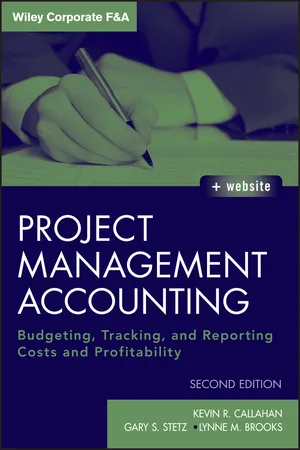
Project Management Accounting
Budgeting, Tracking, and Reporting Costs and Profitability
- English
- ePUB (mobile friendly)
- Available on iOS & Android
Project Management Accounting
Budgeting, Tracking, and Reporting Costs and Profitability
About this book
Over the past few decades, Project Management has shifted from its roots in construction and defense into mainstream American business. However, many project managers' areas of expertise lie outside the perimeters of business, and most do not have the formal education in business, accounting, or finance required to take their skills to the next level. In order to succeed, today's project managers (PMs) who wish to soar to the top or remain at the helm of their profession need to have a comprehensive grasp of the business context within which they work. Providing a resourceful introduction to the interrelationships between finance, accounting, and Project Management, Project Management Accounting, Second Edition is designed to help PMs at various skill levels improve their business skills, provide advanced contributions to their organizations, and perform with greater proficiency.
Authors and industry experts Kevin Callahan, Gary Stetz, and Lynne Brooks combine their decades of Project Management experience and insights to provide professionals in the field with a 360-degree understanding of how costs interact with the general ledger. Through the authors' seasoned expertise, PMs are better equipped to assess all facets of a project with a broader understanding of the "big picture" to determine whether to continue as planned, find an alternative solution, or scrap the project altogether.
Rich with new content as well as many new case studies, this Second Edition of Project Management Accounting includes:
- Updated information on Project Management and its link to Project Accounting
- A new chapter on assessing risk when managing projects
- How to determine the greatest tax/cost savings
- Project Management in relation to a company's mission, objectives, and strategy
- Project Management in an agile business
- Coverage of agile Project Management as applied to software and technical projects
- New, updated, and timely case studies
- Sample checklists to help readers get started and apply concepts to their business
Project managers must make vital decisions every day that impact the schedule, costs, or resources committed to a given project. Project Management Accounting, Second Edition, provides the tools and skills to help PMs establish with greater certainty whether these costs should be capitalized or expensed to stay on budget and improve a company's bottom line.
Frequently asked questions
- Essential is ideal for learners and professionals who enjoy exploring a wide range of subjects. Access the Essential Library with 800,000+ trusted titles and best-sellers across business, personal growth, and the humanities. Includes unlimited reading time and Standard Read Aloud voice.
- Complete: Perfect for advanced learners and researchers needing full, unrestricted access. Unlock 1.4M+ books across hundreds of subjects, including academic and specialized titles. The Complete Plan also includes advanced features like Premium Read Aloud and Research Assistant.
Please note we cannot support devices running on iOS 13 and Android 7 or earlier. Learn more about using the app.
Information
Chapter 1
Project Management and Accounting

Mission, Objectives, Strategy
Information Collection
- Initiation: Project charter
- Planning: Work breakdown structure, project schedule, project budget and cash flow, resource plan, procurement plan, quality plan, risk response plan If the project is for an external client, there may be a request for proposal and corresponding proposal and a contract or some other agreement for services.
- Project Execution and Control: Status reports and dashboards.
Project Initiation
Project Planning
Work Breakdown Structure and Project Schedule
Table of contents
- Cover
- Content
- Title Page
- Copyright
- Dedication
- Preface
- Acknowledgments
- Chapter 1: Project Management and Accounting
- Chapter 2: Finance, Strategy, and Strategic Project Management
- Chapter 3: Accounting, Finance, and Project Management
- Chapter 4: Cost
- Chapter 5: Project Financing
- Chapter 6: Project Revenue and Cash Flows
- Chapter 7: Creating the Project Budget
- Chapter 8: Risk Assessment
- About the Web Site
- Index
- End User License Agreement